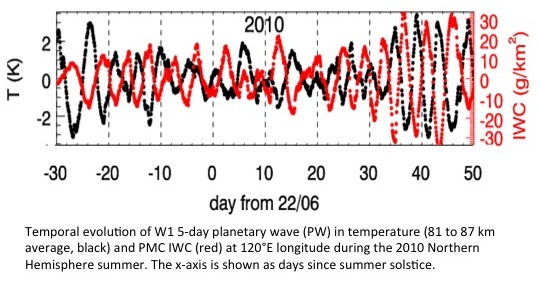|
STATUS:
04.30.2015
Instrument Status:
The AIM spacecraft continues to perform well. All subsystems are operating as expected.
There was an eclipse of the sun by the moon last month (March 20) and AIM was successfully transitioned to its alternate control mode to prevent issues with the primary control mode's handling of such eclipses. After the eclipse, the spacecraft transitioned back to the primary mode and resumed normal operations.
The ground system autonomy for the purpose of performing Relative Time Sequence loads, which was rolled out after the first of the year, has been successful and the initial upload of command sequences which will be necessary to keep AIM functioning in mitigation of the ever increasing beta-angle (angle toward the sun) caused by orbit precession have begun, starting with a new CIPS imaging sequence which will be tested in the next couple of weeks.
CIPS:
The CIPS instrument continues to perform well, with no health issues. During the month of April the CIPS team conducted the post-season calibration analysis for the SH1415 PMC season. As in the past, the calibration changed only minimally over the course of the season, so there was no need to reprocess any of the data.
Efforts are ongoing to investigate season-to-season variability in PMCs. Using OSIRIS PMC data, Gumbel and Karlsson (2011) showed that there is an approximately linear relationship between winter hemisphere stratospheric temperatures and summer hemisphere PMC (or NLC) frequencies during the months of January (southern hemisphere PMCs) and July (northern hemisphere PMCs). This relationship is indicative of interhemispheric teleconnections as a mechanism that controls the cloud frequencies. A similar analysis of CIPS data suggests that the SH seasons of 2009-2010 and 2012-2013 were particularly anomalous, with PMC frequencies much higher than might be predicted just based on teleconnections. The figure here shows the results of Gumbel and Karlsson, which end with the SH 2009-2010 season, as well as the CIPS results. These two seasons will be investigated in more detail to determine why they appear to be anomalous.

Figure Caption. Winter stratosphere temperature anomaly (difference from a multi-year mean) for the months of January (red) and July (blue) vs. PMC (or NLC) occurrence frequency anomaly from OSIRIS (left) and CIPS (right). The temperature anomalies were calculated using temperature data from (left) the European Center for Medium-range Weather Forecasts (ECMWF), and (right) the Microwave Limb Sounder instrument. Courtesy of V. Lynn Harvey.
Reference: Gumbel, J., and B. Karlsson (2011), Intra- and inter-hemispheric coupling effects on the polar summer mesosphere, Geophys. Res. Lett., 38, L14804, doi:10.1029/2011GL047968.
SOFIE:
The SOFIE instrument continues to operate normally. Liu et al. [2015, JGR, in press] recently used SOFIE observations to diagnose 5-day planetary waves (PWs) with zonal wavenumbers ranging from -1 to -3 (eastward propagating mode, E1 - E3), 0 (stationary mode, W0), and 1 to 3 (westward propagating mode, W1 - W3) in the polar stratosphere and mesosphere. The 5-day PWs in temperature are stronger in the polar winter stratosphere and mesosphere and exhibit substantial hemispheric asymmetry. The occurrence of the 5-day wave coincides with the zonal mean zonal wind in each hemisphere. This indicates that the 5-day PWs might be generated from barotropic / baroclinic instability in the polar stratosphere. The relative strengths of 5-day PWs decrease with increasing wavenumbers. The E1 (W1) 5-day PW is stronger than any other mode in winter (summer) and in the stratosphere and lower mesosphere (upper mesosphere). SOFIE temperature and polar mesospheric cloud (PMC) data are derived from simultaneous measurements in the same air column and thus provide a good opportunity to study the phase relationship between the 5-day PWs in temperature and PMCs. This study used the vertical column ice mass abundance (or ice water content, IWC) to represent PMCs. The analyses shows that W1 5-day PWs in T and IWC are ~180° out of phase when their amplitudes are substantial (see Figure below). Furthermore, the phase shift of W1 5-day PW in temperature relative to that in IWC has a mean of -2.0 h (0.3 h) with a standard deviation of 3.8 h (4.2 h) in the Northern Hemisphere (Southern Hemisphere). These results indicate that the formation of the W1 5-day PW in PMCs is controlled mainly by the W1 5-day PW in temperature.

|
